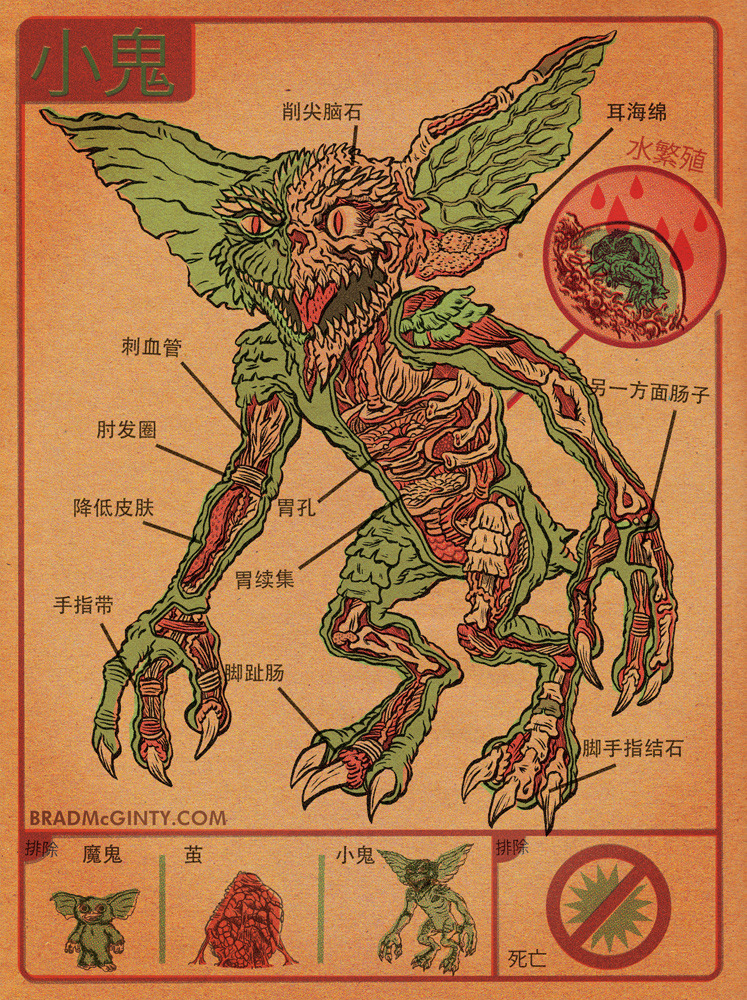 In the 1980s, there was a minor trend going through monster movie circles: little terrors. Gremlins was the start of it.
In the 1980s, there was a minor trend going through monster movie circles: little terrors. Gremlins was the start of it.
From it, we get Critters (1986) and Ghoulies (1985) which both being R Rated and spawners of numerous sequels are . . . still not as well remembered as Gremlins.
Part of the reason for this, I think, is that the idea of a Gremlin is a lot older than the movie which popularized it recently.
Symbolism
The word itself first appeared in the WWII. The creature itself was assigned blame for all sorts of mechanical malfunctions. Primarily in England, this monster spread in popular consciousness through the works of Roald Dahl and the Looney Toons short, Falling Hare.
The Gremlins in the film are symbolically very similar to these first ones.
They are chaos and destruction, though not limited to machinery, they are very adept working machines to cause mischief and terror.
Most of the deaths and injuries in the film are not due to direct actions on the Gremlin’s part, but through their sabotage.
They are a target for blame for the various mechanical maladies people encounter.
The movie adds the bit of them being from Asia (when, really, they’re from England) to add to the idea that they are the manifestations of ‘enemy sabotage’ in WWII.
Every appearance they’ve had in fiction revolves around that and the movies are no different.
There’s also an added theme of responsibility to the creatures. The Gremlins arise because of the improper care and treatment of the source animal – a creature called a Mogwai.
Don’t get them wet and don’t feed them after midnight.
Fail these two points and Gremlins are born. This mirrors, again, technology and machinery. If it is not properly maintained, problems start to build up and ‘gremlins’ appear.
Biology
Gremlins are a very magical creature. A fairy for the industrial age. There are aspects of their nature which openly flout real world biology. Still, we do the best we can. I’ll skip classifying them biologically if only because of their bizarre breeding habits. Otherwise, they’re easily mammals with a lot more scales than a rat. Likely primates.
 |
| Anatomy of a Mogwai |
After cocooning from being ‘fed after midnight’ (the sequel movie questioned the hell out of what exactly this means), the adult Gremlin can reproduce only by becoming wet with water (and only water untainted by more complex chemicals – sort of like the insistence that only ‘cold iron’ can harm fairies) and producing quite diverse offspring (genetically speaking).
 |
| Anatomy of a Gremlin |
There’s no set ratio of water-to-gremlin reproduction and the growth of the creatures from small buds on the ‘mother’ Gremlin’s back is rapid to the point of ridiculousness.
 |
| Gremlin subject “Spike” during mass aquatic reproduction |
Though there is an animal in nature that breeds in a similar way, at least visually. The Surinam Toad keeps the eggs on its back in pouches until they are mature toad-lings. Then they break free and go off to fend for themselves. It’s pretty unnerving to watch.
That’s Gotta itch.
In truth, this is closer to “budding”: a breeding method used by corals, sponges, anemone, plants and fungi. The core animal sprouts off smaller versions of itself in response to an abundance of food. With the Gremlins, there’s a lot more genetic diversity.
The Gremlins, now free, go off to cause mischief and destruction wherever they can. Their behaviors appear as silly antics to us and from appearances serve no real purpose other than to stimulate their brains, like the Keas of New Zealand.
Their diet consists of any sweets they can find and lots of protein. Plants can do in a pinch, but they actively seek out these two foods. Given how active they are, that makes sense. Though they lack fur, they likely have a layer of fat to keep them warm.
The other big rule about Gremlins is that they hate bright lights and sunlight causes them to melt like ice cream in an oven. Being averse to light, for small nocturnal creatures, is a natural thing. A predator for them (which could be something as simple as a coyote or similarly sized predator) would likely be nocturnal as well and they want to avoid being seen.
The melting, that’s much more magic. The best ‘scientific’ explanation is that their bodies are host to very nasty bacteria which use sunlight as part of a reaction that dissolved their flesh and bones. It’s not a great explanation, and has a lot of flaws in it, but at least it’s something.














































































































